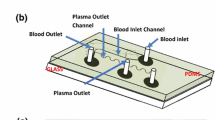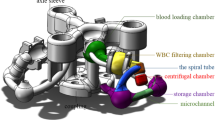Abstract
A thermoplastic microfluidic substrate is conformally integrated onto the cylindrical barrel of a conventional venipuncture syringe, forming a spiral inertial separation element supporting the isolation of plasma from diluted whole blood. The cylindrical shape of the syringe itself serves to define the flow path required for inertial separation by transforming a linear microchannel to a spiral topology. The hybrid system enables inertial plasma separation by Dean flow focusing within the same syringe used for a patient blood draw, with the seamlessly interconnected microfluidic element operated by automated or manual actuation of the syringe plunger. Plasma isolation is achieved without the need for external instrumentation. Device design and fabrication challenges are discussed, and effective plasma isolation within the system is demonstrated, with a peak separation efficiency above 97% using 25 × diluted blood.





Similar content being viewed by others
References
Amini, H., W. Lee, and D. Di Carlo. Inertial microfluidic physics. Lab Chip 14:2739–2761, 2014.
Bhamla, M. S., B. Benson, C. Chai, G. Katsikis, A. Johri, and M. Prakash. Hand-powered ultralow-cost paper centrifuge. Nat. Biomed. Eng. 1:9, 2017.
Brown, J., L. Theis, L. Kerr, N. Zakhidova, K. O’Connor, M. Uthman, Z. M. Oden, and R. Richards-Kortum. A hand-powered, portable, low-cost centrifuge for diagnosing anemia in low-resource settings. Am. J. Trop. Med. Hyg. 85:327–332, 2011.
Burke, J. M., R. E. Zubajlo, E. Smela, and I. M. White. High-throughput particle separation and concentration using spiral inertial filtration. Biomicrofluidics 8:024105, 2014.
Chin, C. D., T. Laksanasopin, Y. K. Cheung, D. Steinmiller, V. Linder, H. Parsa, J. Wang, H. Moore, R. Rouse, G. Umviligihozo, E. Karita, L. Mwambarangwe, S. L. Braunstein, J. van de Wijgert, R. Sahabo, J. E. Justman, W. El-Sadr, and S. K. Sia. Microfluidics-based diagnostics of infectious diseases in the developing world. Nat. Med. 17:1015–1019, 2011.
Di Carlo, D. Inertial microfluidics. Lab Chip 9:3038, 2009.
Fernández, L., and S. A. Schaefer. Relationships among the Neotropical Candirus (Trichomycteridae, Siluriformes) and the evolution of parasitism based on analysis of mitochondrial and nuclear gene sequences. Mol. Phylogenet. Evol. 52:416–423, 2009.
Garg, N., T. M. Westerhof, V. Liu, R. Liu, E. L. Nelson, and A. P. Lee. Whole-blood sorting, enrichment and in situ immunolabeling of cellular subsets using acoustic microstreaming. Microsyst. Nanoeng. 4:17085, 2018.
Gossett, D. R., and D. Di Carlo. Particle focusing mechanisms in curving confined flows. Anal. Chem. 2009. https://doi.org/10.1021/ac901306y.
Guan, G., L. Wu, A. A. Bhagat, Z. Li, P. C. Y. Chen, S. Chao, C. J. Ong, and J. Han. Spiral microchannel with rectangular and trapezoidal cross-sections for size based particle separation. Sci. Rep. 3:1475, 2013.
Hou, H. W., R. P. Bhattacharyya, D. T. Hung, and J. Han. Direct detection and drug-resistance profiling of bacteremias using inertial microfluidics. Lab Chip 15:2297–2307, 2015.
Huh, D., J. H. Bahng, Y. Ling, H.-H. H. Wei, O. D. Kripfgans, J. B. Fowlkes, J. B. Grotberg, and S. Takayama. Gravity-driven microfluidic particle sorting device with hydrodynamic separation amplification. Anal. Chem. 79:1369–1376, 2007.
Inglis, D. W., J. A. Davis, R. H. Austin, and J. C. Sturm. Critical particle size for fractionation by deterministic lateral displacement. Lab Chip 6:655, 2006.
Jiang, H., X. Weng, C. H. Chon, X. Wu, and D. Li. A microfluidic chip for blood plasma separation using electro-osmotic flow control. J. Micromech. Microeng. 21:085019, 2011.
Jung, J., and K.-H. H. Han. Lateral-driven continuous magnetophoretic separation of blood cells. Appl. Phys. Lett. 93:223902, 2008.
Kendall, E. L., M. S. Wiederoder, J. Y. Han, A. Sposito, A. Wilson, and D. L. DeVoe. Soft lithography microfabrication of functionalized thermoplastics by solvent casting. J. Polym. Sci. B Polym. Phys. 53:1315–1323, 2015.
Kim, B., S. Oh, D. You, and S. Choi. Microfluidic pipette tip for high-purity and high-throughput blood plasma separation from whole blood. Anal. Chem. 89:1439–1444, 2017.
Kuntaegowdanahalli, S. S., A. A. S. Bhagat, G. Kumar, and I. Papautsky. Inertial microfluidics for continuous particle separation in spiral microchannels. Lab Chip 9:2973–2980, 2009.
Laurell, T., F. Petersson, and A. Nilsson. Chip integrated strategies for acoustic separation and manipulation of cells and particles. Chem. Soc. Rev. 36:492–506, 2007.
Lee, W., D. Kwon, W. Choi, G. Y. Jung, A. K. Au, A. Folch, and S. Jeon. 3D-printed microfluidic device for the detection of pathogenic bacteria using size-based separation in helical channel with trapezoid cross-section. Sci. Rep. 5:7717, 2015.
Lee, B. S., J.-N. Lee, J.-M. Park, J.-G. Lee, S. Kim, Y.-K. Cho, and C. Ko. A fully automated immunoassay from whole blood on a disc. Lab Chip 9:1548, 2009.
Lee, M. G., J. H. Shin, S. Choi, and J.-K. Park. Enhanced blood plasma separation by modulation of inertial lift force. Sens. Actuators B Chem. 190:311–317, 2014.
MacDonald, M. P., G. C. Spalding, and K. Dholakia. Microfluidic sorting in an optical lattice. Nature 426:421–424, 2003.
Martel, J. M., and M. Toner. Particle focusing in curved microfluidic channels. Sci. Rep. 3:3340, 2013.
Martel, J. M., and M. Toner. Inertial focusing in microfluidics. Annu. Rev. Biomed. Eng. 16:371–396, 2014.
Nakashima, Y., S. Hata, and T. Yasuda. Blood plasma separation and extraction from a minute amount of blood using dielectrophoretic and capillary forces. Sens. Actuators B Chem. 145:561–569, 2010.
Nayak, S., T. Guo, J. Lopez-Rios, C. Lentz, S. Arumugam, J. Hughes, C. Dolezal, V. Linder, A. Carballo-Diéguez, I. C. Balán, and S. K. Sia. Integrating user behavior with engineering design of point-of-care diagnostic devices: theoretical framework and empirical findings. Lab Chip 19:2241–2255, 2019.
Nivedita, N., and I. Papautsky. Continuous separation of blood cells in spiral microfluidic devices. Biomicrofluidics 7:54101, 2013.
Oh, K. W., K. Lee, B. Ahn, and E. P. Furlani. Design of pressure-driven microfluidic networks using electric circuit analogy. Lab Chip 12:515, 2012.
Peeling, R. W., K. K. Holmes, D. Mabey, and A. Ronald. Rapid tests for sexually transmitted infections (STIs): the way forward. Sex. Transm. Infect. 2006. https://doi.org/10.1136/sti.2006.024265.
Peeling, R. W., D. Mabey, A. Herring, and E. W. Hook. Why do we need quality-assured diagnostic tests for sexually transmitted infections? Nat. Rev. Microbiol. 4:909–921, 2006.
Pretlow, T. G., and T. P. Pretlow. Cell separation: methods and selected applications. Cambridge Academic Press 1983. https://doi.org/10.1002/cyto.990060517.
Rafeie, M., J. Zhang, M. Asadnia, W. Li, and M. E. Warkiani. Multiplexing slanted spiral microchannels for ultra-fast blood plasma separation. Lab Chip 16:2791–2802, 2016.
Robinson, M., H. Marks, T. Hinsdale, K. Maitland, and G. Coté. Rapid isolation of blood plasma using a cascaded inertial microfluidic device. Biomicrofluidics 11:024109, 2017.
Sajeesh, P., and A. K. Sen. Particle separation and sorting in microfluidic devices: a review. Microfluid Nanofluidics 17:1–52, 2014.
Siemann, U. Solvent cast technology—a versatile tool for thin film production. Prog. Colloid Polym. Sci. 130:1–14, 2005.
Sollier, E., H. Rostaing, P. Pouteau, Y. Fouillet, and J.-L. Achard. Passive microfluidic devices for plasma extraction from whole human blood. Sens. Actuators B Chem. 141:617–624, 2009.
Song, S., M. S. Kim, and S. Choi. Smart microfluidic pipette tip enabled by flow-rate insensitive particle ordering. Small 10:4123–4129, 2014.
Tripathi, S., Y. V. B. Kumar, A. Agrawal, A. Prabhakar, and S. S. Joshi. Microdevice for plasma separation from whole human blood using bio-physical and geometrical effects. Sci. Rep. 6:26749, 2016.
Tripathi, S., Y. V. B. Varun Kumar, A. Prabhakar, S. S. Joshi, and A. Agrawal. Passive blood plasma separation at the microscale: a review of design principles and microdevices. J. Micromech. Microeng. 25:083001, 2015.
Wang, X., H. Gao, N. Dindic, N. Kaval, and I. Papautsky. A low-cost, plug-and-play inertial microfluidic helical capillary device for high-throughput flow cytometry. Biomicrofluidics 11:14107, 2017.
Warkiani, M. E., G. Guan, K. B. Luan, W. C. Lee, A. A. S. Bhagat, P. KantChaudhuri, D. S. W. Tan, W. T. Lim, S. C. Lee, P. C. Y. Chen, C. T. Lim, and J. Han. Slanted spiral microfluidics for the ultra-fast, label-free isolation of circulating tumor cells. Lab Chip 14:128–137, 2014.
Washington, J. A. Principles of Diagnosis. In: Medical Microbiology, edited by S. Baron. Galveston, TX: University of Texas Medical Branch at Galveston, 1996. https://www.ncbi.nlm.nih.gov/books/NBK8014/
Wong, A. P., M. Gupta, S. S. Shevkoplyas, and G. M. Whitesides. Egg beater as centrifuge: isolating human blood plasma from whole blood in resource-poor settings. Lab Chip 8:2032–2037, 2008.
Wu, L., G. Guan, H. W. Hou, A. A. S. Bhagat, and J. Han. Separation of leukocytes from blood using spiral channel with trapezoid cross-section. Anal. Chem. 84:9324–9331, 2012.
Xi, W., F. Kong, J. C. Yeo, L. Yu, S. Sonam, M. Dao, X. Gong, and C. T. Lim. Soft tubular microfluidics for 2D and 3D applications. Proc. Natl. Acad. Sci. 114:10590–10595, 2017.
Xiang, N., and Z. Ni. High-throughput blood cell focusing and plasma isolation using spiral inertial microfluidic devices. Biomed. Microdevices 17:110, 2015.
Xiang, N., X. Shi, Y. Han, Z. Shi, F. Jiang, and Z. Ni. Inertial microfluidic syringe cell concentrator. Anal. Chem. 90:9515–9522, 2018.
Yeh, E.-C. C., C.-C. C. Fu, L. Hu, R. Thakur, J. Feng, and L. P. Lee. Self-powered integrated microfluidic point-of-care low-cost enabling (SIMPLE) chip. Sci. Adv. 3:e1501645, 2017.
Yu, W. S., H. van Duinen, and S. C. Gandevia. Limits to the control of the human thumb and fingers in flexion and extension. J. Neurophysiol. 103:278–289, 2009.
Zhang, L., F. Tian, C. Liu, Q. Feng, T. Ma, Z. Zhao, T. Li, X. Jiang, and J. Sun. Hand-powered centrifugal microfluidic platform inspired by the spinning top for sample-to-answer diagnostics of nucleic acids. Lab Chip 18:610–619, 2018.
Zhang, X.-B., Z.-Q. Wu, K. Wang, J. Zhu, J.-J. Xu, X.-H. Xia, and H.-Y. Chen. Gravitational sedimentation induced blood delamination for continuous plasma separation on a microfluidics chip. Anal. Chem. 84:3780–3786, 2012.
Zhou, J., and I. Papautsky. Fundamentals of inertial focusing in microchannels. Lab Chip 13:1121, 2013.
Acknowledgments
This research was supported by NSF Grants ECCS1609074 and CMMI1562468. The authors acknowledge the support of the Maryland NanoCenter and its FabLab.
Author information
Authors and Affiliations
Corresponding author
Additional information
Associate Editor Tingrui Pan oversaw the review of this article.
Publisher's Note
Springer Nature remains neutral with regard to jurisdictional claims in published maps and institutional affiliations.
Electronic supplementary material
Below is the link to the electronic supplementary material.
Rights and permissions
About this article
Cite this article
Han, J.Y., DeVoe, D.L. Plasma Isolation in a Syringe by Conformal Integration of Inertial Microfluidics. Ann Biomed Eng 49, 139–148 (2021). https://doi.org/10.1007/s10439-020-02526-9
Received:
Accepted:
Published:
Issue Date:
DOI: https://doi.org/10.1007/s10439-020-02526-9




